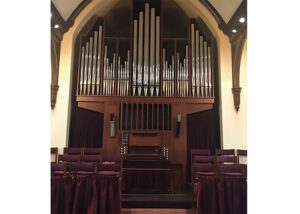Someone I know goes to church on Sunday mornings in a movie theatre. The group worships in a “cheap seats” cinema on the outskirts of our city, nestled in a suburban cluster of big-box stores and strip malls.
“Look, there’s church!” exclaims his four-year-old daughter on mid-week trips in the area. She fails to recognize the building as anything other than the Lord’s house, even though it says Cinema City on the outside.
Of course, I’m all aghast. I immediately have judgmental thoughts and, by reflex, assume a position of superiority. After all, I’m a good Mennonite who enjoys the notion of belonging to a faith group that is somehow separate from—and therefore more righteous than—the evildoers of the world and their dens of iniquity.
We turn to Scripture and exploit Apostle Paul’s words to the church in Rome, “Do not be conformed to the patterns of this world,” to support our half-hearted and mealy-mouthed claim to be in the world but not of it.
There’s something refreshing about the cinema church. At least it’s not pretending to be anything other than a theatre-style sanctuary. Most of the Mennonite churches I know have separate buildings where they gather as audiences to watch weekly shows up front on stage, often augmented with movie-style audio-visual presentations.
In my mind, that’s just as aghast-able as the Cinema City church, maybe even more so. At least the church that meets in the theatre isn’t pretending it is not engulfed by popular culture and aspirations of the North American lifestyle.
But I doubt that Christians can redeem a commercial facility simply by holding their services there. I’ve seen churches meeting in strip malls, derelict gas stations and a reclaimed basketball stadium. Are these places suddenly houses of God because people sing hymns and offer prayers there? I don’t really know.
I watch for other signs of the presence of the divine:
- Where is the stranger and the outcast welcomed?
- Where are the people who were formerly in need and now receiving care from a community?
- Where are warm beds available and vegetables grown for eating?
At First United Church in Vancouver’s Downtown Eastside, more than 100 people are allowed to sleep on its pews on cold winter nights. Columbus Mennonite Church in Ohio dug out asphalt from its parking lot and planted a garden with flowers and shrubs. Wood Heights Baptist Church in Toronto, Ont., converted flower beds into vegetable gardens and use the fresh produce for community meals and distribution at the food bank.
It’s easy to judge Christians by the buildings in which they’ve chosen to worship. I know I’m prone to drawing quick—and often ungracious—conclusions about people based on where they live or the size of their sanctuary. It’s harder, but better, to investigate further and look for signs of hospitality and generosity.
A church in Seattle, Wash., bought an old movie theatre. To offer a service to others, it built storage bins with padlocks for people without homes. “One of the stigmas of homelessness is that you carry all your possessions on your back,” said Jonathan Neufeld, pastor of Seattle Mennonite Church, in an article in Geez magazine, from where most of these examples are taken.
The social climate in the suburbs and cities can be hostile to low-income folks and others in need. Churches in these neighbourhoods may not be what they appear on the outside. Behind their doors there may be agents of love and hope busily offering help and organizing for change.
Aiden Enns is a member of Hope Mennonite Church, Winnipeg, Man., and the editor of Geez magazine. He can be reached at aiden@geezmagazine.org.








Leave a Reply
You must be logged in to post a comment.